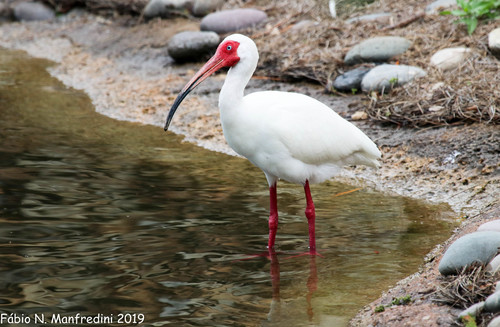
White Ibis
The White Ibis (*Eudocimus albus*) is a striking wading bird, easily recognizable by its brilliant white plumage, long, curved bill, and red legs. It plays a crucial role in wetland ecosystems, helping to control populations of insects, crustaceans, and small fish. Found primarily in the Americas, the White Ibis is a highly social species, often seen foraging and nesting in large colonies. While not currently considered globally threatened, it faces regional threats from habitat loss and degradation. The ibis has held cultural significance in various regions, sometimes appearing in folklore and art.
53-70 cm
Length
85-105 cm
Wingspan
Least Concern
Conservation Status
Distribution
The White Ibis is found along the coasts of the southeastern United States, south through Central America, the Caribbean, and into northern South America, as far south as Peru and Brazil. They are generally non-migratory, though some populations may move seasonally in response to water levels and food availability. They are found in a variety of altitudes, mostly in lower regions.
Lifespan
The average lifespan in the wild is not well documented, but they can live up to 16 years or more in captivity.
White Ibis's Habitat
Habitat Types
Coastal marshes, Mangrove swamps, Estuaries, Mudflats, Inland wetlands, Flooded agricultural fields
Climate Zones
Tropical, Subtropical, Temperate
Adaptations
Their long, curved bill is perfectly adapted for probing in mud and shallow water to find prey. Their long legs allow them to wade in deeper water than many other shorebirds. They also possess specialized tactile receptors in their bills to help detect prey hidden beneath the surface.
Variations
While no formally recognized subspecies exist, there can be some regional variation in size and bill length.
Appearance
Breeding Plumage
Adults have primarily white plumage year-round. During the breeding season, the bare facial skin and legs become a more intense red, and they may develop wispy plumes on the breast and back.
Seasonal Feather Changes
See above. The main seasonal variation is the intensity of the red coloration in the bare parts.
Sex Based Plumage Differences
There is minimal sexual dimorphism in plumage; males and females look alike.
Notable Features
Long, decurved bill, reddish-pink in color., Bare red facial skin, especially vibrant during breeding., Black wingtips, visible primarily in flight., Long, reddish-pink legs.
Diet and Feeding
Primary Foods
Crabs, Crayfish, Small fish, Insects, Snails, Marine worms
Foraging Behavior
White Ibises are tactile foragers, using their long bills to probe in mud, shallow water, and vegetation. They often forage in groups, walking slowly and systematically through their habitat.
Specializations
Their bill's specialized tactile receptors, called Herbst corpuscles, allow them to detect prey they cannot see. This is crucial for finding food hidden in mud or under vegetation.
Seasonal Diet Variations
Diet can vary depending on prey availability. During periods of high water, they may consume more fish. When water levels are lower, they may focus on crustaceans.
Behavior
Social Structure
Highly social; often found in large flocks, both when foraging and roosting. They nest colonially, sometimes in mixed-species colonies with other wading birds.
Communication
Guttural croaking calls, Bill-snapping during courtship, Visual displays (e.g., head-bobbing)
Migration
Generally non-migratory, but some populations may undertake short-distance movements in response to changes in water levels or food availability.
Territorial or Group Behaviors
While they are highly social, breeding pairs will defend a small territory around their nest within the larger colony. Foraging flocks are generally non-territorial.
Conservation
Threats
Habitat loss and degradation (due to coastal development, drainage of wetlands, and agricultural expansion), Pollution (pesticides, heavy metals), Changes in water management practices, Disturbance at nesting colonies
Protection Programs
Protection of wetland habitats through national and international agreements (e.g., Ramsar Convention), Monitoring of populations, Management of water levels to benefit wading birds
Local National Laws
Protected under the Migratory Bird Treaty Act in the United States.
Population Trend
Stable
Population Estimates
The global population is estimated to be around 1,500,000 individuals.
Interesting Facts
Juvenile White Ibises have brown and white plumage.
This provides camouflage and helps them blend in with their surroundings while they are still vulnerable.
White Ibises can sometimes hybridize with Scarlet Ibises where their ranges overlap.
This results in offspring with intermediate plumage coloration, ranging from pale pink to orange.
The White Ibis is the mascot of the University of Miami.
Chosen for its presence in South Florida and its courageous behavior.
Faqs about White Ibis
Are White Ibises endangered?
No, the White Ibis is currently classified as 'Least Concern' by the IUCN. However, they face regional threats from habitat loss.
What is the difference between a White Ibis and an egret?
While both are white wading birds, ibises have long, curved bills, while egrets have straight, pointed bills. Ibises also have bare facial skin, which egrets lack.
Do White Ibises migrate?
Most populations are non-migratory, but some may move locally in response to changing water conditions.
What do I do I see an injured Ibis?
Do not approach. Contact your local animal control, wildlife rehabilitation center, or state wildlife agency.
Copyright @ Nature Style Limited. All Rights Reserved.
 English
English